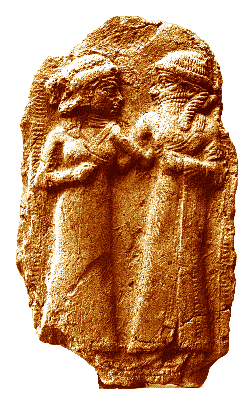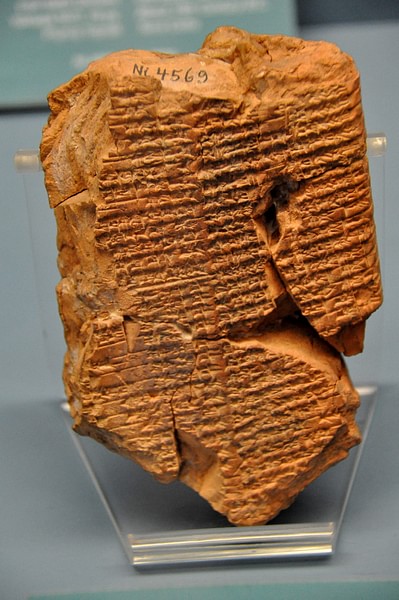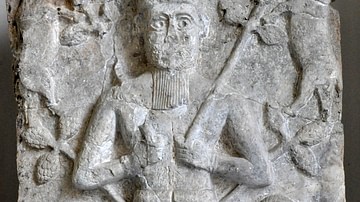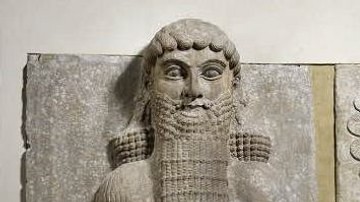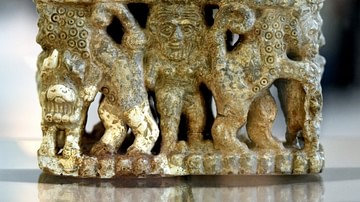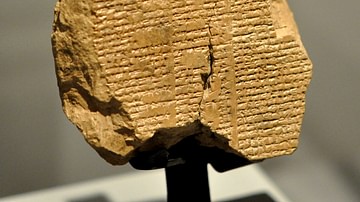The Sumerian poem, The Descent of Inanna (c. 1900-1600 BCE) chronicles the journey of Inanna, the great goddess and Queen of Heaven, from her realm in the sky, to earth, and down into the underworld to visit her recently widowed sister Ereshkigal, Queen of the Dead. The poem begins famously with the lines:
From the Great Above she opened her ear to the Great Below
From the Great Above the goddess opened her ear to the Great Below
From the Great Above Inanna opened her ear to the Great Below.
(Wolkstein and Kramer, 52)
The work then goes on to describe Inanna's descent to the underworld accompanied, part of the way, by her faithful servant and advisor Ninshubur.
Summary
Inanna is dressed in her finest clothes and wears the crown of heaven on her head, beads around her neck, her breastplate, golden ring and carries her scepter, the rod of power. Just before she enters the underworld, she gives Ninsubur instructions on how to come to her aid should she fail to return when expected. Upon her arrival at the gates of the underworld Inanna knocks loudly and demands entrance. Neti, the chief gatekeeper, asks who she is and, when Inanna answers, “I am Inanna, Queen of Heaven”, Neti asks why she would wish entrance to the land “from which no traveler returns.” Inanna answers:
Because of my older sister, Ereshkigal
Her husband, Gugalanna, the Bull of Heaven, has died
I have come to witness the funeral rites.
(Wolkstein and Kramer, 55)
Neti then tells her to stay where she is while he goes to speak with Ereshkigal.
When Neti delivers the news to Ereshkigal that Inanna is at the gates, the Queen of the Dead responds in a way which seems strange: “She slapped her thigh and bit her lip. She took the matter into her heart and dwelt on it” (Wolkstein and Kramer, 56). She does not seem pleased to hear the news that her sister is at the gate and her displeasure is further evidenced when she tells Neti to bolt the seven gates of the underworld against Inanna and then let her in, one gate at a time, requiring her to remove one of her royal garments at each gate. Neti does as he is commanded and, gate by gate, Inanna is stripped of her crown, beads, ring, sceptre, even her clothing and, when she asks the meaning of this indignity, is told by Neti:
Quiet, Inanna, the ways of the underworld are perfect
They may not be questioned.
(Wolkstein and Kramer 58-60)
Inanna enters the throne room of Ereshkigal “naked and bowed low” and begins walking toward the throne when:
The annuna, the judges of the underworld, surrounded her
They passed judgment against her.
Then Ereshkigal fastened on Inanna the eye of death
She spoke against her the word of wrath
She uttered against her the cry of guilt
She struck her.
Inanna was turned into a corpse
A piece of rotting meat
And was hung from a hook on the wall.
(Wolkstein and Kramer, 60)
After three days and three nights waiting for her mistress, Ninshubur follows the commands Inanna gave her, goes to Inanna's father-god Enki for help, and receives two `galla', two transgender beings created "neither male nor female", to aid her in returning Inanna to the earth. The galla enter the underworld “like flies” and, following Enki's specific instructions, attach themselves closely to Ereshkigal. The Queen of the Dead is seen in distress:
No linen was spread over her body
Her breasts were uncovered
Her hair swirled around her head like leeks.
(Wolkstein and Kramer, 63-66)
The poem continues to describe the queen experiencing the pains of labor. The galla sympathize with the queen's pains and she, in gratitude, offers them whatever gift they ask for. As ordered by Enki, the galla respond, “We wish only the corpse that hangs from the hook on the wall” (Wolkstein and Kramer, 67) and Ereshkigal gives it to them. The galla revive Inanna with the food and water of life and she rises from the dead.
As in the Greek myth of Demeter and Persephone, however, one who has sojourned in the underworld cannot just leave it so easily. Someone must be found to take Inanna's place and so the galla demons of the underworld accompany her up to the earth's surface to claim her substitute. The demons try to take Ninshubur first, then Inanna's sons Shara and Lulal and even Inanna's beautician Cara but, in all these instances, Inanna prevents them because Ninshubur, Shara, Lulal and Cara are all dressed in sackcloth and are in mourning for her apparent death.
When Inanna comes upon her lover Dumuzi, however, and finds him “dressed in his shining…garments…on his magnificent throne” she becomes enraged that he, unlike the others, is not mourning her and orders the demons to seize him. Dumuzi appeals to the sun god Utu for help and is transformed into a snake in order to escape but, eventually, is caught and carried away to the underworld. Dumuzi's sister, Geshtinanna, volunteers herself to go in his place and so it is decreed that Dumuzi will spend half the year in the underworld and Geshtinanna the other half. In this way, as, again with the myth of Demeter and Persephone, the seasons were explained. Yet why so elaborate a myth simply to explain the seasons? The Greek tale of Persephone (though, also, about much more than seasonal change) accomplishes the same end more succinctly.
Modern Interpretation
Modern readers of this poem have available to them a wealth of interpretation of the piece through writers applying a psychological, specifically Jungian, view to the poem as an archetypal myth of the journey each individual must take to reach wholeness. Inanna in this piece, so the interpretation goes, is not a `whole person' until she appears vulnerable before her `darker half', dies, and returns to life. At the poem's end, this interpretation asserts, Inanna, through her descent into darkness, the shedding of the trappings of her former self, confrontation with her `shadow', death of who she was, and final re-birth, is now a complete individual, wholly aware. Writers who have popularized this interpretation are so numerous that naming them all would be pointless; any reader acquainted with The Descent of Inanna will have already, or will eventually, come across one version or another of this interpretation.
The archetypes of Carl Jung have proven enlightening tools in understanding and explicating ancient myths for a modern audience (most notably through the works of Joseph Campbell). Such an interpretation of a text, however, must always keep in mind the text itself; the words on the page, the arrangement of those words, characterization and dialogue. However interesting, and even enlightening, the modern `Jungian' view of The Descent of Inanna may be, it is not supported by the text. Among other glaring omissions, this modern interpretation of the ancient story in no way accounts for the last lines of the poem which praise, not Inanna, but Ereshkigal:
Holy Ereshkigal! Great is your renown!
Holy Ereshkigal! I sing your praises!
(Wolkstein and Kramer, 89)
The text of the poem clearly states Inanna's intention of journeying to the underworld to attend the funeral of her brother-in-law, specifies her sister's displeasure at her visit, further specifies how the Annuna of the dead pass judgment against Inanna and how, after that, she is killed by Ereshkigal through the “word of wrath” and the “cry of guilt' and a blow, after which Inanna is hung on a hook, “a rotting piece of meat.” The story continues to detail how Inanna is saved by her father-god Enki and how, finally, two people, Dumuzi and Geshtinanna, who had nothing to do with Inanna's decision to visit the underworld, end up paying the price for it.
Backstory of the Work
A clearer understanding of The Descent of Inanna is available to any reader acquainted with the Sumerian work The Epic of Gilgamesh (c. 2150-1400 BCE), which, whether extant in written form at the time of the composition of The Descent of Inanna, was certainly known by oral transmission.
In the Epic, after the great heroes Gilgamesh and Enkidu have killed the demon Humbaba in the Cedar Forest, their fame is great and Gilgamesh, after washing and dressing himself in royal robes, attracts the attention of Inanna (who, in the Epic, is known by her Akkadian/Babylonian name, Ishtar). Inanna tries to seduce Gilgamesh to become her lover, promising him all good things but Gilgamesh spurns her, citing the many lovers she has had in the past whom she discarded when they no longer interested her and who all met with bad ends. He says to her:
Your lovers have found you like a brazier which smoulders in the cold, a backdoor which keeps out neither squall of wind nor storm, a castle which crushes the garrison, pitch that blackens the bearer, a water skin that chafes the carrier. (Sandars 85-87)
Then, after detailing the misery her lovers have endured at her hands, Gilgamesh concludes saying, “And if you and I should be lovers, should not I be served in the same fashion as all these others whom you loved once?”(Sandars, 85-87). Inanna, upon hearing this, falls into a “bitter rage” and appeals to her father-god Anu (as she has Ninshubur do to Enki in the Descent) in tears over the insults Gilgamesh has heaped upon her. Anu's answer is that she has only gotten what she deserved through her “abominable behavior” (Sandars, 87).
Inanna, in no way pacified by this response, demands that Anu give her Gugalanna, the Bull of Heaven, that she might avenge herself on Gilgamesh and threatens that, if she does not get her way, she will break the doors of the underworld open, “there will be confusion of people, those above with those from the lower depths. I shall bring up the dead to eat food like the living; and the hosts of the dead will outnumber the living” (Sandars, 87). Gugalanna, the Bull of Heaven, is the husband of Inanna's sister Ereshkigal.
When Anu consents and gives her the Bull of Heaven she brings Gugalanna down to the city of Uruk to destroy Gilgamesh. The bull snorts and the earth opens and “a hundred young men fell down to death. With his second snort cracks opened and two hundred fell down to death” (Sandars, 88).
Gilgamesh and Enkidu then join in battle with the Bull of Heaven and kill him. Inanna, enraged further, appears on the walls of Uruk and curses the heroes, prompting Enkidu to tear off the bull's right thigh and hurl it at her. This presumption, on the part of a mortal, cannot be endured by the gods and they decree that Enkidu must die lest more mortals come to think more highly of themselves than they should. Enkidu is stricken with illness and suffers for days before finally dying (Sandars, 88-95).
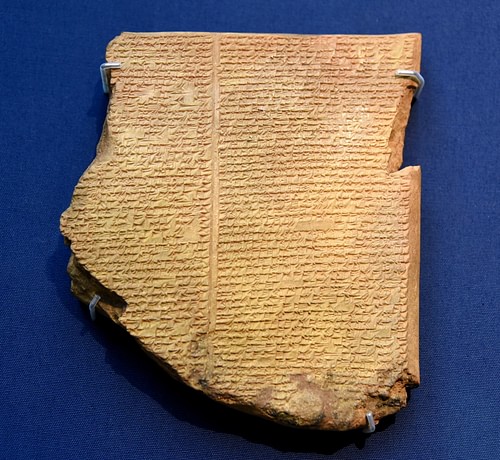
A Clearer Interpretation
If a reader is acquainted with the story of Gilgamesh then The Descent of Inanna is more easily understood within the context and culture of ancient Mesopotamia. Inanna, showing no more regard for her sister's feelings than she did for the three hundred innocent young men she killed with the Bull of Heaven, decides she will attend the funeral of the brother-in-law whose death she is responsible for.
Once a reader understands that Inanna caused the death of Ereshkigal's husband Gugalanna, the Queen of the Dead's response upon hearing of her arrival is completely understandable, as is Inanna's subsequent judgment by the Annuna and death at Ereshkigal's hands. The “word of wrath” and the “cry of guilt” make perfect sense in this context as Ereshkigal is confronting the one responsible for her present grief; a grief made even greater by her pregnancy and the imminent birth of a child who will have no father.
As in The Epic of Gilgamesh, however, Inanna is able to manipulate the father-god figure into getting her what she wants; in that case the Bull of Heaven and, in this, a return to life. Inanna is ressurected and, in the same way that Enkidu and the three hundred young men paid the price for Inanna's indignation, Dumuzi and Geshtinnana pay for her insensitivity and rashness in deciding to attend Gugalanna's funeral.
The moral which an ancient hearer of The Descent of Inanna might take away from it, far from a `symbolic journey of the self to wholeness' is the lesson that there are consequences for one's actions and, further, might also be consoled in that if bad things happened to gods and heroes due to the unpredictability of life, why should a mortal bemoan unhappy fate?
Conclusion
In ancient Mesopotamia, humans regarded themselves as co-workers with the gods and the gods lived among them; Inanna lived in the city of Uruk, Enki at Eridu, and so on. The gods were not far away beings but were intimately tied to the daily lives of the people of the land and what affected a god would, invariably, affect those people directly.
Though one of the gods could have only the best intentions, another god could thwart whatever good was hoped for. Ereshkigal is praised at the end of the poem because she sought justice in killing Inanna. The fact that this justice was denied, even to a goddess of such power as the Queen of the Dead, would have ameliorated the sting of the daily injustices and disappointments suffered by the people hearing the tale.
The Descent of Inanna, then, about one of the gods behaving badly and other gods and mortals having to suffer for that behavior, would have given to an ancient listener the same basic understanding anyone today would take from an account of a tragic accident caused by someone's negligence or poor judgment: that, sometimes, life is just not fair.
